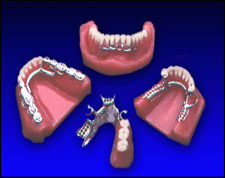المقالات
Lower Partial

A lower partial denture can be a good way to replace missing teeth. When you save your remaining teeth and have a partial denture, you ll chew better, look better, and have a healthier mouth. A typical lower partial denture is held in place by metal clasps that fit around the anchor teeth.
The process of making a lower partial denture involves a series of appointments. Though the process varies in each individual case, it usually involves minor shaping of the teeth followed by impressions. Models are made from the impressions, and it s on the models that the partial framework and final partial denture are fabricated in a dental laboratory. After several try-ins and adjustments, the partial denture is seated.
Typical lower partial denture A partial denture prevents several problems. By filling in spaces, it prevents neighboring teeth from shifting. If missing teeth aren t replaced, it can set off a chain reaction that can result in cavities and periodontal disease. It also helps balance your bite. This means you ll chew better and have a healthier jaw joint. Partials also add support to your cheeks and lips. This support is necessary to speak clearly and look your best.
Some temporary problems are a normal part of adjusting to a new lower partial denture. At first, it may tip when you chew. You may notice increased salivary flow. It may seem bulky. You may gag a little. Your tongue will feel crowded, and you may have difficulty speaking. But don t worry; as you g et used to your new partial, these problems will go away. With time and practice, you ll make the adjustment and be eating with confidence.
